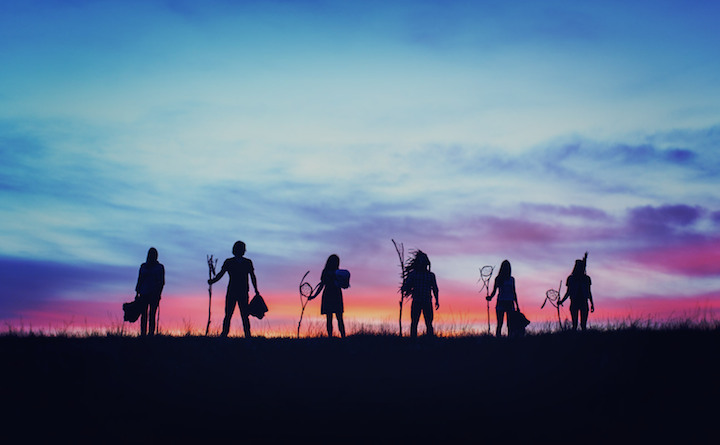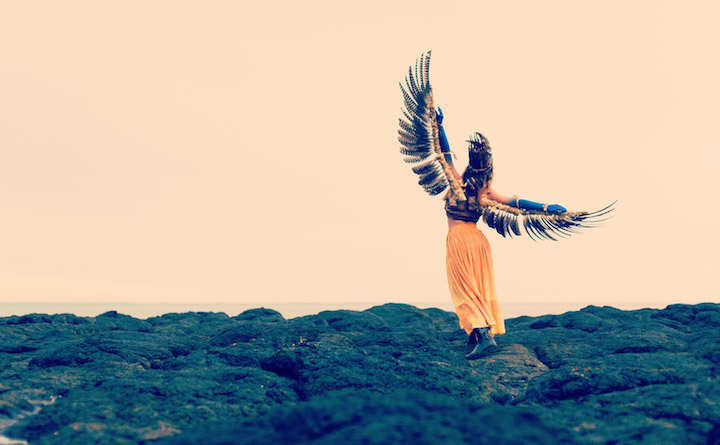
Music festivals are, almost by definition, supposed to have their fingers on the cultural pulse. Thus it hardly augurs well that the Beyond the Valley festival—a new player in Australia’s already-crowded music festival scene, to take place on Phillip Island over New Year’s Eve and New Year’s Day—has chosen to promote itself through a series of videos that tick nearly every box of colonial appropriation from Native American cultural traditions. A debate about the use and misuse of war bonnets (traditionally worn only by male warriors of certain Plains Indian groups) has been raging in both North America and the United Kingdom since a Canadian electronic music festival, Bass Coast, advised attendees that war bonnets or anything resembling them would not be permitted onsite. For an Australian festival to launch a publicity campaign that places white Australians in war bonnets front and centre in this climate looks less like carelessness than a deliberate provocation.
Despite this, the reaction to Beyond the Valley’s appropriative branding has hardly been fierce. On social media a few brave souls made some noise by posting on the Festival’s Facebook page—including an incredible pro bono MS Paint rebrand by a concerned observer—and firing off some angry tweets. Some unflattering coverage in Tonedeaf and The Monthly compared the festival’s branding to Meredith Music Festival’s recent addition of ‘offensive costumes’ to their list of banned items. The organisers of Beyond the Valley have since issued an apology of sorts: “Our artwork reflects a love of global traditions and is in no way intended to challenge or offend and we sincerely apologise to those who have perceived our artwork and branding as offensive.” This tepid fauxpology has not been accompanied by any concrete plans for the festival’s rebranding, although a story at theMusic.com.au claims that “[the festival] are now doing ‘everything they can’ to remove offensive footage, including a video on their website that included a male in a war bonnet, and will be changing the name of their premium camping option from ‘Chief Camp’.” The promotional videos still remain online, ((The videos in question have been removed by Beyond the Valley’s publicity team since the original publication of this article.)) and the festival’s website is still branded with hokey simulacra of Native American symbolism: bear claws, particoloured bird plumage, and crossed arrows abound.
The festival’s core audience seems not to care at all about the issue or the apology—indeed, most of the feedback about the apology on the festival’s Facebook page appears to be of the ‘political correctness gone mad!’ and ‘reverse racism!’ variety. One particularly memorable response—‘liked’ by the festival’s Facebook page itself—says of the festival’s critics, “You stand for ‘equality’ yet are asking people to change their artwork because they want to use parts of a culture that isn’t theres [sic]. I just hope that one day you can get on my motherfucking level and evolve.” This may have more than a little to do with white Australians’ notorious inability to perceive or care about racism beyond all but the most egregious cases (such as a Darlinghurst café owner who recently point-blank told a job interviewee that he wouldn’t be hired because he is black). But the general lack of outrage about the festival’s branding and its half-hearted ‘we’re sorry if you were offended’ apology also has much to do with white Australian culture’s disavowal of our country’s own Indigenous past, and its position within broader global cultural flows and counter-flows.
The land on which Beyond the Valley will take place traditionally belonged to the Boonwurrung (or Bunurong) people of the Kulin nation; a people whose numbers were reduced to a mere 28 or so after 52 years of contact with white Europeans. The Beyond the Valley festival website makes no mention of the Boonwurrung people, nor even hosts a perfunctory acknowledgement that Phillip Island was once not the kind of place where hordes of young people could come to dance to the anodyne pop of the Preatures. Its engagement with the history of Phillip Island is limited to some rather bland PR speak: “This beautiful seaside location offers the perfect summer landscape and one within which we hope to provide the perfect outlet for your individual expression.” That one’s ‘individual expression’ might be shaped by the broader forces of culture, history, and language is rendered moot in this neoliberal paradise: come one, come all to beautiful Phillip Island, where you too can dress up in any way you want, as long as you have the money for such creature comforts as “our pioneer pop-up luxury hotel with its very own concierge and first class amenities including our daily hangover spa.”
As risible as Beyond the Valley’s publicity is, the festival’s constant deployment of Native American imagery—or, to be more precise, white American imagery that signifies an imaginary concept of Native American identity—raises a question of the role distance plays in cultural appropriation. Part of the reason that Plains Indian war bonnets have become a flashpoint at music festivals in North America is that they are being worn by people with no Plains Indian heritage on land that once belonged to America’s first nations: for the survivors of colonisation, this appropriation is salt in the wound of a continuing dispossession. By contrast, there is no connection between the land on which Beyond the Valley will take place and the cultural symbolism appropriated by festival’s PR team and designers.
Furthermore, the fetishisation of Native American symbolism of all kinds—the arrows, feathers, bear claws, dreamcatchers and teepees that have become Beyond the Valley’s symbolic bread and butter—has come to Australia via a broader displaced nostalgia for ‘vintage’ white North American culture. Everywhere one cares to look, youth culture in Australia labours under an adoration of the United States in the 20th century—we don baseball caps and Ray-Ban Wayfarers, and dine out at expensive diner-style restaurants that serve pan-USA comfort food (pulled pork sliders, deep-fried pickles, buttermilk chicken, all washed down with Brooklyn Lager, complete with retro-nostalgic logo and NYC hipster cachet). Those caught wearing war bonnets in North America are quick to defend themselves by claiming that their appropriation is a form of ironic homage to Native American people; in Australia our appropriation is doubly ironic, an appropriation of an appropriation, which gives Australian war bonnet wearers a certain amount of plausible deniability. We also run a much lower risk of offending any Native Americans: the organisers of Beyond the Valley can rest soundly knowing that it is unlikely that any members of a small, economically disadvantaged minority in a far-off country will engage with their promotional campaign, or even turn up onsite later in the year.
Beyond the Valley’s reckless deployment of these cultural signifiers does, however, draw attention to the near-complete lack of engagement with Indigenous Australia within the mainstream music festival circuit. There are some notable exceptions: both the Meredith Music Festival and Golden Plains begin each festival with a short acknowledgement of the traditional owners of the land, and the Woodford Folk Festival commences with a welcome to country ceremony in which members of the Jinibara nation play an integral role. (A more ambitious standalone festival of global Indigenous culture, The Dreaming, has been folded into the broader Woodford Folk Festival programming due, apparently, to lack of funding.) The vast majority of mainstream music festivals ignore the issue completely. While Beyond the Valley are clearly on the wrong side of tastemakers’ opinions on the issue of cultural appropriation (thus the apology), it has also inadvertently revealed a broader problem of the erasure of Indigenous Australian history and culture from these sites of communal revelry—which is a problem that not even the most well-meaning of onsite costume policies or perfunctory acknowledgements of country can fix.
